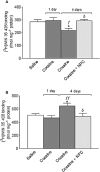Dopamine transporter down-regulation following repeated cocaine: implications for 3,4-methylenedioxymethamphetamine-induced acute effects and long-term neurotoxicity in mice
- PMID: 20015297
- PMCID: PMC2823365
- DOI: 10.1111/j.1476-5381.2009.00522.x
Dopamine transporter down-regulation following repeated cocaine: implications for 3,4-methylenedioxymethamphetamine-induced acute effects and long-term neurotoxicity in mice
Abstract
Background and purpose: 3,4-Methylenedioxymethamphetamine (MDMA) and cocaine are two widely abused psychostimulant drugs targeting the dopamine transporter (DAT). DAT availability regulates dopamine neurotransmission and uptake of MDMA-derived neurotoxic metabolites. We aimed to determine the effect of cocaine pre-exposure on the acute and long-term effects of MDMA in mice.
Experimental approach: Mice received a course of cocaine (20 mg*kg(-1), x2 for 3 days) followed by MDMA (20 mg*kg(-1), x2, 3 h apart). Locomotor activity, extracellular dopamine levels and dopaminergic neurotoxicity were determined. Furthermore, following the course of cocaine, DAT density in striatal plasma membrane and endosome fractions was measured.
Key results: Four days after the course of cocaine, challenge with MDMA attenuated the MDMA-induced striatal dopaminergic neurotoxicity. Co-administration of the protein kinase C (PKC) inhibitor NPC 15437 prevented cocaine protection. At the same time, after the course of cocaine, DAT density was reduced in the plasma membrane and increased in the endosome fraction, and this effect was prevented by NPC 15437. The course of cocaine potentiated the MDMA-induced increase in extracellular dopamine and locomotor activity, following challenge 4 days later, compared with those pretreated with saline.
Conclusions and implications: Repeated cocaine treatment followed by withdrawal protected against MDMA-induced dopaminergic neurotoxicity by internalizing DAT via a mechanism which may involve PKC. Furthermore, repeated cocaine followed by withdrawal induced behavioural and neurochemical sensitization to MDMA, measures which could be indicative of increased rewarding effects of MDMA.
Figures





Similar articles
-
Cocaine potentiates MDMA-induced oxidative stress but not dopaminergic neurotoxicity in mice: implications for the pathogenesis of free radical-induced neurodegenerative disorders.Psychopharmacology (Berl). 2013 Nov;230(1):125-35. doi: 10.1007/s00213-013-3142-5. Epub 2013 May 17. Psychopharmacology (Berl). 2013. PMID: 23681166
-
Relevance of MDMA ("ecstasy")-induced neurotoxicity to long-lasting psychomotor stimulation in mice.Psychopharmacology (Berl). 2003 Mar;166(3):241-8. doi: 10.1007/s00213-002-1320-y. Epub 2003 Feb 18. Psychopharmacology (Berl). 2003. PMID: 12590354
-
Long-lasting behavioral sensitization to psychostimulants following p-chloroamphetamine-induced neurotoxicity in mice.Neuropharmacology. 2004 Jan;46(1):74-84. doi: 10.1016/s0028-3908(03)00316-2. Neuropharmacology. 2004. PMID: 14654099
-
Rats classified as low or high cocaine locomotor responders: a unique model involving striatal dopamine transporters that predicts cocaine addiction-like behaviors.Neurosci Biobehav Rev. 2013 Sep;37(8):1738-53. doi: 10.1016/j.neubiorev.2013.07.002. Epub 2013 Jul 12. Neurosci Biobehav Rev. 2013. PMID: 23850581 Free PMC article. Review.
-
Neurotoxicity of methamphetamine and 3,4-methylenedioxymethamphetamine.Life Sci. 2014 Feb 27;97(1):37-44. doi: 10.1016/j.lfs.2013.07.014. Epub 2013 Jul 24. Life Sci. 2014. PMID: 23892199 Free PMC article. Review.
Cited by
-
Effects of MDPV on dopamine transporter regulation in male rats. Comparison with cocaine.Psychopharmacology (Berl). 2019 Mar;236(3):925-938. doi: 10.1007/s00213-018-5052-z. Epub 2018 Oct 4. Psychopharmacology (Berl). 2019. PMID: 30284596
-
Gene expression in the addicted brain.Int Rev Neurobiol. 2014;116:251-73. doi: 10.1016/B978-0-12-801105-8.00010-2. Int Rev Neurobiol. 2014. PMID: 25172478 Free PMC article. Review.
-
The ugly side of amphetamines: short- and long-term toxicity of 3,4-methylenedioxymethamphetamine (MDMA, 'Ecstasy'), methamphetamine and D-amphetamine.Biol Chem. 2011 Jan;392(1-2):103-15. doi: 10.1515/BC.2011.016. Biol Chem. 2011. PMID: 21194370 Free PMC article. Review.
-
Cocaine self-administration produces pharmacodynamic tolerance: differential effects on the potency of dopamine transporter blockers, releasers, and methylphenidate.Neuropsychopharmacology. 2012 Jun;37(7):1708-16. doi: 10.1038/npp.2012.17. Epub 2012 Mar 7. Neuropsychopharmacology. 2012. PMID: 22395730 Free PMC article.
-
Cocaine potentiates MDMA-induced oxidative stress but not dopaminergic neurotoxicity in mice: implications for the pathogenesis of free radical-induced neurodegenerative disorders.Psychopharmacology (Berl). 2013 Nov;230(1):125-35. doi: 10.1007/s00213-013-3142-5. Epub 2013 May 17. Psychopharmacology (Berl). 2013. PMID: 23681166
References
-
- Amara SG, Kuhar MJ. Neurotransmitter transporters: recent progress. Annu Rev Neurosci. 1993;16:73–93. - PubMed
-
- Bennett BA, Hyde CE, Pecora JR, Clodfelter JE. Long-term cocaine administration is not neurotoxic to cultured fetal mesencephalic dopamine neurons. Neurosci Lett. 1993;153:210–214. - PubMed
-
- Benuck M, Lajtha A, Reith ME. Pharmacokinetics of systemically administered cocaine and locomotor stimulation in mice. J Pharmacol Exp Ther. 1987;243:144–149. - PubMed
-
- Blakely RD, Bauman AL. Biogenic amine transporters: regulation in flux. Curr Opin Neurobiol. 2000;10:328–336. - PubMed
-
- Camarero J, Sanchez V, O'Shea E, Green AR, Colado MI. Studies, using in vivo microdialysis, on the effect of the dopamine uptake inhibitor GBR 12909 on 3,4-methylenedioxymethamphetamine (‘ecstasy’)-induced dopamine release and free radical formation in the mouse striatum. J Neurochem. 2002;81:961–972. - PubMed
Publication types
MeSH terms
Substances
LinkOut - more resources
Full Text Sources
Medical

